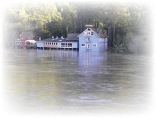New Publication Addresses the Role of Atmospheric Rivers in Causing Flooding of California's Russian River
July 20, 2006
 Results from experiments conducted by NOAA Earth System Research Laboratories and SCRIPPS researchers have
been published in the July 2006 issue of Geophysical Research Letters. From 1997-2005 ground observations were
collected around the Russian River watershed of northern California and combined with offshore satellite data in
order to study the transport of water vapor from the Equatorial Pacific to the U.S. West Coast, and its impact on
severe storms and flooding. A major finding was that the presence of the phenomenon, referred to as "atmospheric
rivers," were a cause of heavy rainfall during seven separate flood events. However, not all landfalling atmospheric
rivers led to flooding.
Results from experiments conducted by NOAA Earth System Research Laboratories and SCRIPPS researchers have
been published in the July 2006 issue of Geophysical Research Letters. From 1997-2005 ground observations were
collected around the Russian River watershed of northern California and combined with offshore satellite data in
order to study the transport of water vapor from the Equatorial Pacific to the U.S. West Coast, and its impact on
severe storms and flooding. A major finding was that the presence of the phenomenon, referred to as "atmospheric
rivers," were a cause of heavy rainfall during seven separate flood events. However, not all landfalling atmospheric
rivers led to flooding.
Background:
Seeking to improve severe storm forecasts on the Pacific Coast, researchers during the California Jets (CALJET) and
Pacific Jets (PACJET) experiments worked to understand atmospheric rivers; a key process in linking weather and
climate. Atmospheric rivers strongly influence both short-term weather and flood prediction, as well as seasonal
climate anomalies and the global water cycle. These experiments led to the development of the NOAA
hydrometeorological Testbed (HMT) Program; a program aimed at accelerating the infusion of new technologies,
models, and scientific results from the research community into daily forecasting operations of the National Weather
Service (NWS), and its River Forecast Centers (RFCs), in order to improve flood forecasts.
Significance:
These results document the important role of atmospheric rivers in creating high impact hydrologic events. The
concept of atmospheric rivers has resonated with field forecasters during this last winter's HMT field study. The
American water Works association requested a briefing on the subject at its annual meeting last month where
Climate Change Impacts on Water Supply was the focus, and the community of flood control, water supply and
reservoir operators of California see this as a key phenomenon to understand, monitor and predict as they work
to mitigate the risks of major urban inundation in Sacramento. Longer-term studies may also allow better coupling
of climate forecasts with seasonal weather forecasts to improve water usage during drought and flood seasons.
This research supports NOAA's mission goals of understanding climate variability and change to enhance society's
ability to plan and respond, and serving society's needs for weather and water information.
| Contact: Marty Ralph | More Information: Abstract of Paper |